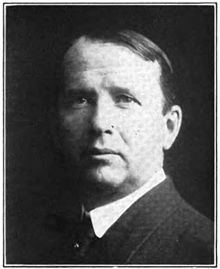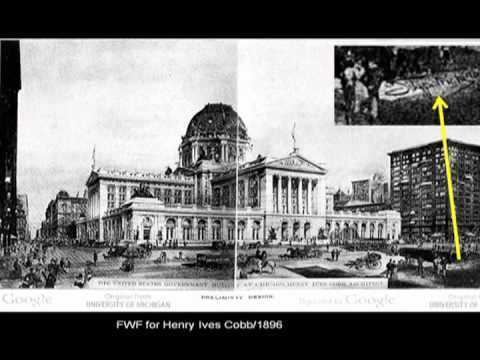Name Francis Fitzpatrick | ||
 | ||
Born April 9, 1863 ( 1863-04-09 ) Montreal, Canada Died July 10, 1931, Evanston, Illinois, United States | ||
Francis w fitzpatrick artist architect author advocate and athlete
Francis Willford Fitzpatrick (April 9, 1863 – July 10, 1931) was an architect in Duluth, Minnesota, Washington, DC, Omaha, Nebraska,and Evanston, Illinois. He often abbreviated his name as F. W. Fitzpatrick in publications and correspondence. Fitzpatrick was an early advocate of fireproof buildings, and he was a frequent columnist in architectural trade publications on a variety of topics.
Contents
- Francis w fitzpatrick artist architect author advocate and athlete
- Early life
- Traphagen and Fitzpatrick
- List of Traphagen and Fitzpatrick designs
- Chicago Federal Building
- Private practice
- Invention of the skyscraper
- Ideas opinions and quotations
- Death
- References

Early life

Fitzpatrick was born in Montreal, Canada on April 9, 1863. His parents were John and Mary Fitzpatrick. He immigrated to the United States in 1883 and began working as a drafter in the office of Minneapolis architect Leroy Buffington, remaining until 1887. Then in 1888, Fitzpatrick worked at the offices of the brothers Fremont D. Orff and George W. Orff. He formed the Minnesota Decorating Company and successfully contracted for the interior painting and decorating of the 107-room Dacotah Hotel in Grand Forks, North Dakota in 1889.
He joined the American Institute of Architects in 1889.
Traphagen and Fitzpatrick
After completing his work at the Dacotah Hotel, Fitzpatrick moved to Duluth, Minnesota and formed a partnership, Traphagen and Fitzpatrick, with Oliver G. Traphagen that lasted from 1890 to 1896. This was his most productive time as an architect.
List of Traphagen and Fitzpatrick designs
The partnership ended in 1896 when Traphagan relocated to Hawaii and Fitzpatrick moved to Washington, D.C.
Chicago Federal Building
In 1896 Fitzpatrick accepted a position as assistant to the Supervising Architect at the United States Treasury. Prior to the Tarsney Act of 1893, federal buildings were designed by architects at the treasury. Fitzpatrick entered government service at a time when federal architects were becoming advisors and supervisors on federal building contracts with design work more in the hands of private architects. At the treasury, Fitzpatrick worked for Jeremiah O'Rourke and then for William Aiken. Fitzpatrick was assigned to the Chicago Federal Building project as an assistant to architect Henry Ives Cobb, and he moved to Chicago to become one of many supervisors of construction. Soon Fitzpatrick was the only supervisor of construction, and his relationship with Cobb deteriorated for reasons of procurement and process related to construction. Fitzpatrick resigned from the project in 1903 and returned to private practice two years before the building was completed.
Private practice
Fitzpatrick became a consulting architect in 1903, and he specialized in fire prevention designs. He also worked with other architects to solve design problems. His favorite area of expertise may have been Architectural rendering, and he enjoyed submitting drawings for competition awards.
By 1917, Fitzpatrick joined the Bankers Realty Investment Company in Omaha, Nebraska as head of the architectural department. The company designed and built residential and commercial structures capitalized by investors. While at Bankers, he designed the Hotel Yancey in Grand Island, Nebraska, the Blackstone Hotel in Omaha, and a hotel in Sioux City, Iowa. The job did not last long, and in 1919 Fitzpatrick moved to Evanston, Illinois and continued as a consulting architect.
Invention of the skyscraper
An editorial in the June 22, 1907, issue of The American Architect and Building News reported that three architects had claimed credit for inventing the skyscraper:
The editorial stated that in the opinion of the American Institute of Architects (AIA), Jenny had the better claim, although his design was similar to the framing of an 1856 shot tower in the great swamp of New York City.
The July 13, 1907, issue of The American Architect and Building News contained a letter from F. W. Fitzpatrick refuting the conclusions of the AIA titled, "The Origination of the Steel Skeleton Idea." In his letter, Fitzpatrick claimed that he himself had designed steel skeletons in support of church towers prior to 1883, and he had sketched the steel column and horizontal beam design for Buffington's 12-story Tribune building when he was working for Buffington in 1883.
Then in 1912, an article in The Washington Post credited Fitzpatrick with inventing the skyscraper. Claims about Fitzpatrick's role in early skyscraper design were not actively contested, but the opinion of the AIA may have been more accurate.
Ideas, opinions, and quotations
Fitzpatrick was a frequent contributor to various trade publications and newspapers. In his research, historic preservationist Ed Zimmer counted over 200 articles and letters to the editor by Fitzpatrick on architecture and other topics. Fitzpatrick's style was frequently grandiloquent and passionate, but his vision was often accurate.
Death
While crossing the street in Evanston, Fitzpatrick was fatally struck by a car on July 10, 1931. An obituary at the time described his life,
"handsome, tall, graceful, eager, affectionate, generous, an extraordinary athlete, horseman and fencer. Mr. Fitzpatrick was all of these and like Leonardo de Vinci, he was an inventor and an architect."
